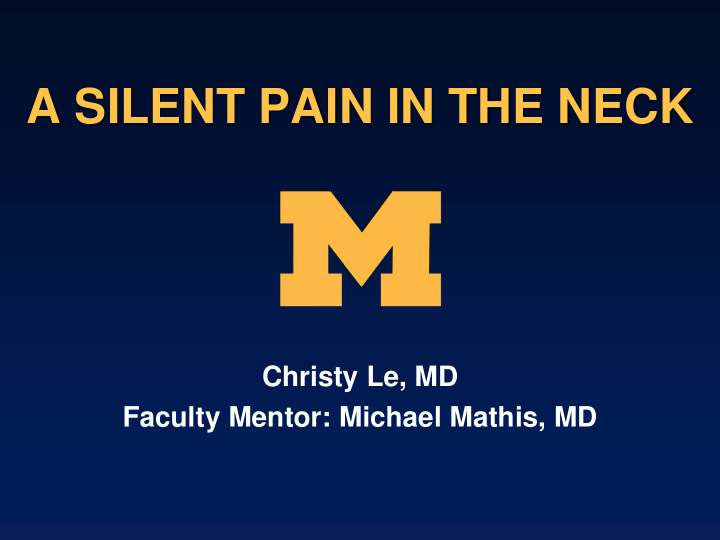



A SILENT PAIN IN THE NECK Christy Le, MD Faculty Mentor: Michael Mathis, MD
Case: 85 yo M, ASA 3 Left Carotid Stenosis Elective L CEA PMHx/PSHx: HTN HLD CAD s/p 3vCABG ( 2008 ) & PCI to RCA ( 2009 ) w/ NSTEMI ( Feb 2018 ) LHC done, no intervention at that time. CHF – LVEF 55%. Grade 2 LV diastolic dysfunction & LVH Bilateral carotid artery stenosis s/p R CEA ( 2006 ) PAD s/p left ilio-femoral bypass ( 1971 ) & bilateral aorto-femoral bypass ( 2001 )
Case: 85 yo M, ASA 3 Left Carotid Stenosis Elective L CEA Meds: ASA, clopidogrel, metoprolol, losartan, amlodipine, furosemide, rosuvastatin Social Hx: former tobacco use: 36 pack-years All: metoclopramide, morphine, nicacin, oxycodone-apap, ranitidine, statins, temazepam Labs: Studies: CTA Neck: >90% stenosis proximal LICA (Jan 2018)
Case: 85 yo M, ASA 3 Left Carotid Stenosis Elective L CEA GA + ETT, A-line Uncomplicated intra-op course: Bovine pericardial patch angioplasty Heparinized & reversed w/ protamine Blake drain placed Extubated awake Moderate care for postoperative monitoring
Post-op Day #1 Developed mild neck swelling overnight — status closely monitored Complained of trouble eating breakfast in the AM and some hoarseness Surgeon requested urgent return to OR neck exploration
Patient Evaluation History : For L CEA: Grade 2 mask, Grade 2b view 2 attempts; success w/ cricoid + bougie Symptoms : Endorsed dysphagia & hoarseness Denied dyspnea or orthopnea
Airway Changes Physical Exam
OR Take-back: Neck Exploration Initial Airway Plan: RSI with Glidescope OR arrival moved to OR table (flat) orthopnea & obstructive breathing RSI aborted & began prepping for awake endoscopic intubation: Glycopyrrolate 0.8 mg, esmolol 30 mg Lidocaine via nebulizer & atomized spray 17 minutes later awake endoscopic intubation attempt by anesthesia attending
Endoscopic Intubation
OR Take-back: Neck Exploration ENT & Anesthesia Airway Consult Team paged STAT to OR. Discussion between Vascular Surgeon/Anes/ENT re: opening left neck Dexamethasone 10 mg given 4 th awake intubation attempt by ENT, SpO2 decreased to <85% Neck prepped w/ betadine by ENT Respiratory arrest during neck prep requiring emergent trach by ENT. 15-blade vertical & horizontal incision. ETT placed into trachea. <15 seconds from arrest to ETCO2 confirmation. Bilateral breath sounds confirmed. SpO2 nadir 30s immediately improving to 90s.
OR Take-back: Neck Exploration Induction of GA after trach Formalization of trach – ETT exchanged for 6-0 cuffed shiley Left neck re-opened by vascular surgery 50 cc of old clot evacuated within the deep layer from omohyoid muscle and from a previously clipped vein New JP drain placed Admitted to ICU
Hematomas After Neck Surgery Carotid Endarterectomy Incidence: 1.4% - 5.5% Anterior Cervical Discectomy Incidence: 1% - 11% Cervical Nerve Blocks Stellate ganglion block Internal Jugular Vein Cannulation
Hematomas After Neck Surgery • Risk factors: – Non-reversal of heparin – Intraop hypotension – Hypertensive swings & coughing at extubation – Temporary intraluminal carotid shunt
Neck Surgery & Post-op Monitoring Close observation, early detection, & preparation for emergent airway management Signs and symptoms: Early indicators may be non-specific: Neck tightness, pain/pressure, swelling, sweating, agitation, anxiety, change in voice quality, dysphagia Respiratory-specific: stridor, hypoxia, dyspnea, tachypnea, tracheal deviation Repeated neck circumference measurements Surgeon to assess post-op bleeding risk Continued observation vs. surgical intervention
Post-surgical Neck Hematomas: Mechanisms of Airway Obstruction Arterial vs. Venous Superficial vs. Deep Contributing Mechanisms: Physical pressure effect Development of perilaryngeal edema Blood dissection along tissue planes
Contributing Mechanisms Physical Pressure Effect Displacement of laryngeal inlet away from midline position Physical compression of laryngeal & tracheal lumen
Contributing Mechanisms Development of Perilaryngeal Edema Often out of proportion to degree of externally visible neck swelling/discoloration Hematoma interference w/ venous/lymphatic drainage Release of tissue inflammatory mediators Swollen supraglottic mucosal folds may obscure glottic opening
Contributing Mechanisms Blood Dissection Along Tissue Planes Blood can spread remotely from initial location. RP collections of blood often manifest as neck pain & dysphagia in addition to hoarseness and dyspnea. Compression of arytenoid cartilages adduct vocal cords. Shift laryngeal inlet anteriorly.
Neck Hematomas & Airway Management Emergent Intubation: Difficult bag mask ventilation Difficult intubation Consider previous airway history Identify neck landmarks for possible surgical airway
Neck Hematomas & Airway Management Inhalational induction Intravenous induction Awake oral or nasal intubation Awake open cricothyrotomy or tracheotomy under local
Airway Management in Patients with Neck Hematomas After CEA Shakespeare, William; Lanier, William; Perkins, William; Pasternak, Jeffrey Anesthesia & Analgesia. 110(2):588-593, February 2010.
Failed Awake Endoscopic Intubations Natural progression of disease process Systemically administered sedative agents Laryngospasm Insufficient airway topicalization Patient panic
ASA Difficult Airway Algorithm
Michigan OxyTain Algorithm ✓ ✓ ✓ ✓
Take Home Points
Back To Our Patient... Flex laryngoscopy on POD #4 from emergent trach and neck hematoma evacuation. Continued but improved edema. Decannulated on POD #6. Discharged home on POD #7. Doing well since!
References Airway Management of the Patient with a Neck Hematoma, Hung OR, Murphy MF. Hung's Difficult and Failed Airway Management, 3e; 2017 Self, et al. Risk factors for postcarotid endarterectomy hematoma formation. Can J of Anaesth. 1999. 46:635-640 Fountas, et al. Anterior cervical discectomy and fusion associated complications. Spine. 2007. 32(21):2310-7 Sagi, et al. Airway complications associated with surgery on the anterior cervical spine. Spine. 2002. 27:949-953 Lee, et al. Patterns of Post-thyroidectomy Hemorrhage. Clin Exp Otorhinolaryngol. 2009. 2(2):72-7 Kua, et al. Airway obstruction following internal jugular vein cannulation. Anaesthesia. 1997. 52(8);776-80 Mishio, et al. Delayed severe airway obstruction due to hematoma following stellate gangioln block. Reg Anesth Pain Med. 1998 (23(5):516-9 Shakespeare, et al. Airway management in patients who develop neck hematomas after carotid endarterectomy. Anesthesia & Analgesia. 2010. 110(2):588-593 Rosenblatt, et al. Preoperative endoscopic airway examination (PEAE) provides superior airway information and may reduce the use of unnecessary awake intubation. Anesth Analg. 2011; 112(3):602-607 Augoustides, et al. Difficult airway management after carotid endarterectomy: utility and limitations of the Laryngeal Mask Airway. J of Clinical Anesthesia. 2007; 19(3); 218-221 Heard, et al. The formulation and introduction of a ‘can’t intubate, can’t ventilate’ algorithm into clinical practice. Anaesthesia . 2009;64: 601-608
Questions?
Recommend
More recommend